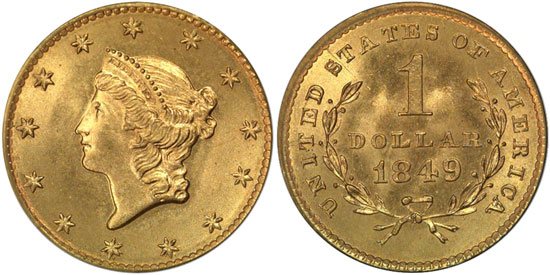Guide to U.S. Liberty Gold Dollars
The Liberty Gold Dollar was struck from 1849 to 1854 and represented the first series for the smallest gold denomination produced by the United States Mint. The authorization for the denomination followed the discovery of gold in California, which had prompted Congress to expand the use of gold within the monetary system. Under the original system created by the Coinage Act of 1792, three gold denominations were authorized known as the quarter eagle, half eagle, and eagle, with values of two dollars and fifty cents, five dollars, and ten dollars, respectively. The Coinage Act of 1849 would expand the range of gold denominations, adding the lower value gold dollar and the higher value twenty dollar double eagle.

1849 Liberty Gold Dollar
Although the gold dollar was not introduced until 1849, its origins can be traced back to 1836, when the denomination was first proposed. At the time, the silver dollar had not been produced for three decades, and some suggested that a gold dollar would be more logical and easier to use. Gold dollars had been struck privately by the Bechtler family in Georgia and proved to be popular within local commerce. The Philadelphia Mint prepared patterns struck in a composition of 90% gold and 10% copper, but no further progress was made. In 1844, the same dies were used to strike patterns in an alloy of 90% gold and 10% silver, but once again the project stalled. The discovery of gold in California and new gold interests would finally lead to the authorization of the denomination.
Initial patterns for the gold dollar had already focused on the size, since it was apparent that they could not be very large. Among the most interesting 1849-dated patterns are those slightly larger than a dime, with a hole in the center to allow the coins to have a larger diameter while still containing only one dollar worth of gold. United States Mint Chief Engraver James Barton Longacre had also designed a small number of patters which included a square hole instead of the round one seen in other patterns, but none of the designs were ever put into use.
The final design for the gold dollar was created by Longacre and featured the head of Liberty on the obverse. She is facing left and wearing a headband inscribed LIBERTY with thirteen stars surrounding. The reverse of the coin contains a wreath encircling the denomination “1 DOLLAR” and the date. The words UNITED STATES OF AMERICA appear around the wreath. The first year of the series saw two distinct varieties, identified by differences in the reverse design. On the earliest coins and all coins struck at the Dahlonega and New Orleans Mint, the wreath is open, while on later Philadelphia and Charlotte coins the wreath is closed. The closed wreath design would be used until the end of the type in 1854.
Following their introduction, the new gold dollars became a source of much criticism from the public. Their small size made them difficult to handle and somewhat easy to lose. In the ensuing years, the idea of producing coins with a hole in the center was once again contemplated, but ultimately it was decided to make the coins thinner and wider. The change in specifications along with a new design was introduced in 1854, and the denomination would continue to be struck until it was discontinued in 1889. The short-lived Liberty Gold Dollars now stand as the smallest diameter coins ever produced by the United States Mint and are reminiscent of a turbulent and intriguing period of American history.

